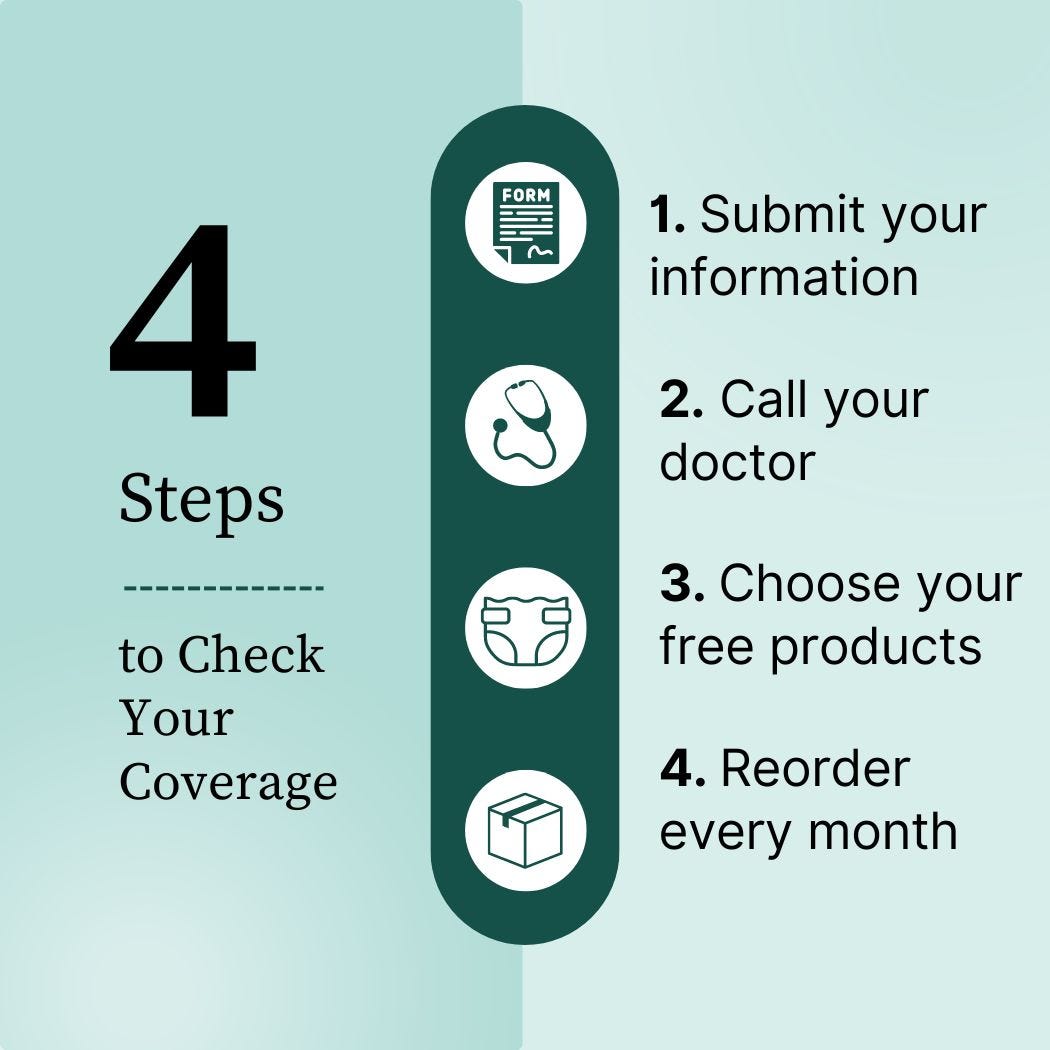Key Takeaways:
-
Everyone stims! Understanding this helps you support your loved one's unique communication and coping skills.
-
Instead of stopping stimming, focus on understanding its purpose and finding safe ways to accommodate it.
-
By embracing stimming, you help create a more inclusive world for everyone and ensure your loved one gets the support they need, including essential incontinence supplies through Aeroflow Urology.
As caregivers, we often observe behaviors in our loved ones that might puzzle us or cause concern. One such behavior is "stimming," or self-stimulatory behavior.
While it's commonly associated with autism, stimming is a natural human behavior, and understanding it can empower us to better support those we care for.
At Aeroflow Urology, we believe in providing comprehensive support and resources for caregivers. Just as understanding stimming can help you provide better care, understanding your loved one's insurance coverage can help you access essential supplies.
Let's dive into what stimming really is and why it's so important.
What Exactly Is Stimming?
Stimming is any repetitive behavior involving our bodies or the movement / placement of objects. Think of it as how our bodies respond to internal or external stimuli.
It can manifest in various ways, engaging different senses:
- Visual stimming: Focusing on repetitive visual input (e.g., staring at a fan, watching lights).
- Auditory stimming: Repeating sounds or seeking specific auditory input (e.g., humming, listening to the same song repeatedly).
- Tactile stimming: Engaging in repetitive touch sensations (e.g., rubbing textures, fidgeting with objects).
- Vestibular stimming: Repetitive movements related to balance and spatial awareness (e.g., rocking, spinning).
- Olfactory / gustatory stimming: Repetitive behaviors involving taste or smell (e.g., sniffing objects, mouthing non-food items).
At its core, all human behavior serves a purpose, and stimming is no exception. It's a powerful form of self-expression and communication, even when it's not immediately clear what it means. Every human being craves connection and needs effective ways to communicate; communication is a fundamental human and disability right.
Stimming is often an independent, sometimes involuntary, means of self-expression. Whether we recognize it or not, it serves a function and has its own purpose.


Habits Vs. Stims: The Key Differences
You might be thinking, "Isn't that just a habit?" It's a great question, and while some behaviors can overlap, there are key differences between habits and stims. Many everyday actions, like nail-biting or pen-chewing, are often considered nervous habits. But what sets stims apart?
Consider these distinctions:
Habits
- Can be instinctive and not always apparent to others.
- Become automatic, requiring little thought or effort.
- Often learned over time as part of a routine, with a clear function (e.g., locking the door, turning off lights).
- Can be completely void of intentional behavior or emotion.
- More easily changed or broken (like in toilet training protocols).
- May be temporary and not a vital, indefinite drive.
Stims
- Tend to be more intense and specific than everyday habits.
- Often a vital, neurologically-driven behavioral response.
- Serve as a coping mechanism to ease overwhelm, express emotion, or self-regulate/self-soothe.
- Can be completely involuntary with no clear intent.
- Not necessarily learned behaviors.
- May be a lifelong behavioral response that is difficult to change, control, or stop.
- Driven by how our brains process information and respond to cope.
- Can be significantly influenced by conditions like OCD tendencies, fixations, nervous system stress responses, anxiety, ADHD traits, and sensory processing overwhelm.
- Many stims are far more than mere habits and may require further attention, investigation, and accommodations, especially if they become self-injurious or harmful.
Check your coverage for 100% free incontinence products now!
Check your coverage for 100% free incontinence products now!
How Autistic Stimming Can Differ
It's crucial to understand that stimming is not exclusive to individuals with an autism diagnosis. In fact, everyone stims! Your stims might just be less noticeable or more "socially acceptable."
Have you ever:
- Twirled your hair when bored or tired?
- Bitten your nails or tapped your feet when nervous?
- Played with your bracelets or rings repeatedly?
- Hummed a little tune to yourself over and over?
- Chewed on the end of a pen or doodled while on the phone?
- Stared into space, out a window, or at a ceiling fan for significant periods?
- Tapped your feet repeatedly or paced when waiting?
If so, you stim too! Just because your stim is more common or ordinary doesn't make it any less of a stim than that of a neurodivergent individual.
While everyone stims, the key difference in stimming behavior for autistic individuals often lies in its intensity, duration, and impact. For someone with ASD, stimming may be:
- Unconscious or difficult to stop.
- Much more time-consuming, repetitive, intense, and compulsive.
- Visually different from "acceptable societal norms," such as intense hand flapping, rocking back and forth, meticulously lining up objects, or repeating loud verbal stims.
These differences can sometimes be problematic, distressing, or even debilitating. They may unfortunately invite negative reactions or comments from others, disrupt daily life, or even put the person at risk of harm or bullying. Some stims can even be self-injurious.
Autistic stimming can also vary in intensity, becoming more pronounced during times of transition, routine changes, unpredictable environments, or when feeling overstimulated. These stims can also serve as a vital neurologically-driven response and coping mechanism during stressful periods, and you may even be able to track patterns. (Keeping a written record can be helpful for discussions with medical professionals!)
These stims are often involuntary and can be a lifelong behavioral response that's hard to change. They are driven by how the brain processes information and attempts to cope. Autistic stimming can be heavily influenced by OCD tendencies, fixations, ADHD traits, nervous system stress responses, anxiety, and the need for sensory exploration or relief from sensory overwhelm.
Unfortunately, repetitive movements that appear "extraordinary" can lead to snap judgments and misconceptions about an individual. This highlights the ongoing need for greater awareness and advocacy. Has your autistic loved one ever been misunderstood or judged for simply being "different?"
We live in a society with many rules, expectations, and norms. While these aren't inherently bad, they can be incredibly challenging and exclusionary for individuals with disabilities, medical conditions, or neurodivergence.
When Stimming Becomes Disruptive
Sometimes, stimming can become disruptive, particularly verbal stimming if it's loud, highly distracting, or puts a loved one at risk of bullying. Loud, repetitive verbal stimming can even be an attempt to numb intense anxiety.
Important Note for Caregivers: It's vital to recognize that anxiety in autistic individuals can present very differently. When you have concerns, always consult a trusted doctor or a psychiatrist experienced in autism and neurodivergent conditions.
Stimming as a Smart Solution
Imagine existing in a world not quite built for you. When words fail, and other communication methods fall short, stimming can become the most raw and honest expression of emotion.
What "big emotions" might stimming convey?
- Fear, anxiety, panic, distress.
- Anger, pain, frustration.
- Boredom, restlessness, excitement, energy.
- Exuberance, joy, happiness, contentment, love.
- Insecurity, mistrust.
When verbal communication isn't accessible, stimming can become a prominent way for someone to express themselves fully, openly, and accurately. It's a truly intelligent adaptive strategy.
Creating Predictability Through Stimming
For many autistic individuals, stimming offers reassurance and comfort. It's a way to create a sense of predictability in an unpredictable world. How smart is that?
Predictability eases anxiety, fear of the unknown, and apprehension about what comes next. This is also why autistic individuals might prefer watching the same shows or movies repeatedly, or "script" lines from them – predictability fights anxiety. Maintaining structure and routine is a powerful tool in a caregiver's toolkit.
Just because we may not understand different stims doesn't make them bad, less real, less valid, or wrong. Different is simply different!
Stimming Solutions & Accommodations
As caregivers, we naturally want to support our loved ones. Consider these questions:
- What if the stimming is highly inappropriate or puts them at risk for bullying?
- How can self-injurious stims be handled?
- How can I ensure my loved one's need to stim is accommodated outside of my direct care?
What You Can Do
- Redirect or offer replacement stims: If stims are inappropriate or harmful, gently attempt to redirect to another stim or provide a safe, alternative stim.
- Seek professional help: Don't hesitate to contact professionals like Occupational Therapists, Sensory Integration Therapists, Psychiatrists, or Developmental Pediatricians when necessary.
- Ensure accommodations: Advocate for appropriate accommodations in school and other settings, such as sensory breaks.
- Avoid reprimanding: It's crucial that no one reprimands an individual who is stimming to cope or maintain focus. Phrases like "quiet hands" are exclusionary and should be omitted.
Embracing Stimming Acceptance
The overarching message today is one of respect for the need to stim. Terms like "respect the stim," "stimming positivity," and "stimming acceptance" are gaining traction online – and for good reason.
The only exception to this acceptance is when stimming becomes self-injurious or harmful to others. In an increasingly neurodiversity-accepting and neurodiversity-affirming world, embracing stimming acceptance can make the world a better place for everyone.
Don't Let Incontinence Be a Barrier to Care
Understanding and accommodating your loved one's needs, including stimming, is vital to providing compassionate care. Just as important is ensuring they have access to the essential supplies they need to live comfortably and with dignity.
Incontinence supplies, like diapers and pull-ups, can be a significant expense. The good news is that many insurance plans cover these necessary products.
Don't wait to find out if your loved one qualifies for free incontinence supplies through their insurance!
Fill out our Eligibility Form today and let Aeroflow Urology help you navigate the process. It's quick, easy, and completely free to check their coverage!
Get Free Women's Incontinence Supplies With Aeroflow Urology
Disclaimer
Information provided on the Aeroflow Urology blog is not intended as a substitute for medical advice or care from a healthcare professional. Aeroflow recommends consulting your healthcare provider if you are experiencing medical issues relating to incontinence.











